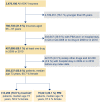Association between Potentially Inappropriate Medication (PIM) Use and Risk of Hospitalization in Older Adults: An Observational Study Based on Routine Data Comparing PIM Use with Use of PIM Alternatives
- PMID: 26840396
- PMCID: PMC4740421
- DOI: 10.1371/journal.pone.0146811
Association between Potentially Inappropriate Medication (PIM) Use and Risk of Hospitalization in Older Adults: An Observational Study Based on Routine Data Comparing PIM Use with Use of PIM Alternatives
Abstract
Objective: The safety of potentially inappropriate medications (PIMs) in elderly patients is still debated. Using the PRISCUS list, we examined the incident all-cause hospitalization risk associated with PIMs compared to PIM alternatives during the 180 days post individual first pharmacy dispensing (index date).
Methods: Routine claims data from a German health insurer on 392,337 ambulatory patients aged ≥65 years, were used to estimate adjusted hazard ratios (HRs) for hospitalization associated with incident PIM use. Observation period was January 2009 -December 2010. Users of PIM alternatives, as defined by the PRISCUS list, were the reference group. Patients with PIM dispensing or hospital stay in a six month "washout" period (second half of 2008) were excluded. All potential confounders were determined in the half year before the individual index date.
Results: In the total cohort 60.7% were female. Median age was 73 years. Of 79,041 incident PIM users, 58.4% had PIMs dispensed in one quarter of 2009 or 2010, 19.3% in two quarters, and 22.3% in three or more quarters. There were 126,535 hospitalizations during the observation period, and 47,470 of them occurred within 180 days post first dispensing. Multivariable Cox regression analysis revealed PIM use as a significant risk factor for hospitalization (HR 1.378; 95% CI 1.349-1.407) compared to use of PIM alternatives.
Conclusions: PIM use compared to use of PIM alternatives is associated with an increased risk of all-cause hospitalization in the 180 days following individual index date. Future analyses comparing a single PIM with its corresponding alternative may help identify those PIMs responsible for this.
Conflict of interest statement
Figures




References
-
- Beers MH. Explicit criteria for determining potentially inappropriate medication use by the elderly. An update. Archives of internal medicine. 1997;157(14):1531–6. Epub 1997/07/28. . - PubMed
Publication types
MeSH terms
LinkOut - more resources
Full Text Sources
Other Literature Sources

